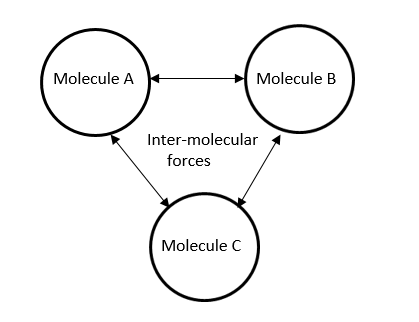
What is the nature of molecular forces?
Answer
504.3k+ views
Hint: Intermolecular forces are the very important one because they determine the physical property of the many objects such as solid, liquid and gas. Intermolecular forces play an important role in science and regular life. Because the hydrogen bond is more important so that the water is produced.
Complete step by step answer:
The force between the molecules is known as intermolecular forces. Intermolecular forces are observed between the atoms and molecules. Intermolecular forces are electrostatic in nature and also having other forces includes van der Waals forces and hydrogen bonds. Based on the intermolecular forces, the object may classify as solid, liquid and gas. In solids, the intermolecular forces are very high. In liquids, the intermolecular forces are slightly less than solids and in gas, the intermolecular forces very less.
In general, there are two types of intermolecular forces. They are Attractive intermolecular forces and Dispersive intermolecular forces. Attractive intermolecular forces are classified into Hydrogen bonding (H-Bonding) and Ionic bonding (Ion-induced dipole forces). Hydrogen bonds are the strongest intermolecular force. Dispersion intermolecular forces are the weakest intermolecular forces.
In solids the particles are arranged in some pattern. So, that the intermolecular forces are very high. In liquids, the particles are close together but not arranged in some pattern. So, that the intermolecular forces are less. But in gas, the particles are very far apart and not in regular arrangement. So, that the intermolecular forces are very less.

Significance of intermolecular forces:
1. Intermolecular forces are the very important one because they determine the physical property of the many objects such as solid, liquid and gas.
2. In solids, the intermolecular forces are attractive in nature. In liquids, the intermolecular forces are slightly attractive and slightly repulsive in nature. But in gas, the intermolecular forces are repulsive in nature.
Note:
The four key intermolecular forces are very important. They are Ionic bond, Hydrogen bond, Van der Waals dipole-dipole interactions, Van der Waals dispersion forces. These are the major and important intermolecular forces. Boiling points are a measure of intermolecular bonds. The intermolecular forces increase with increasing polarization of bonds.
Complete step by step answer:
The force between the molecules is known as intermolecular forces. Intermolecular forces are observed between the atoms and molecules. Intermolecular forces are electrostatic in nature and also having other forces includes van der Waals forces and hydrogen bonds. Based on the intermolecular forces, the object may classify as solid, liquid and gas. In solids, the intermolecular forces are very high. In liquids, the intermolecular forces are slightly less than solids and in gas, the intermolecular forces very less.
In general, there are two types of intermolecular forces. They are Attractive intermolecular forces and Dispersive intermolecular forces. Attractive intermolecular forces are classified into Hydrogen bonding (H-Bonding) and Ionic bonding (Ion-induced dipole forces). Hydrogen bonds are the strongest intermolecular force. Dispersion intermolecular forces are the weakest intermolecular forces.
In solids the particles are arranged in some pattern. So, that the intermolecular forces are very high. In liquids, the particles are close together but not arranged in some pattern. So, that the intermolecular forces are less. But in gas, the particles are very far apart and not in regular arrangement. So, that the intermolecular forces are very less.

Significance of intermolecular forces:
1. Intermolecular forces are the very important one because they determine the physical property of the many objects such as solid, liquid and gas.
2. In solids, the intermolecular forces are attractive in nature. In liquids, the intermolecular forces are slightly attractive and slightly repulsive in nature. But in gas, the intermolecular forces are repulsive in nature.
Note:
The four key intermolecular forces are very important. They are Ionic bond, Hydrogen bond, Van der Waals dipole-dipole interactions, Van der Waals dispersion forces. These are the major and important intermolecular forces. Boiling points are a measure of intermolecular bonds. The intermolecular forces increase with increasing polarization of bonds.
Recently Updated Pages
Express the following as a fraction and simplify a class 7 maths CBSE

The length and width of a rectangle are in ratio of class 7 maths CBSE

The ratio of the income to the expenditure of a family class 7 maths CBSE

How do you write 025 million in scientific notatio class 7 maths CBSE

How do you convert 295 meters per second to kilometers class 7 maths CBSE

Write the following in Roman numerals 25819 class 7 maths CBSE

Trending doubts
State and prove Bernoullis theorem class 11 physics CBSE

What are Quantum numbers Explain the quantum number class 11 chemistry CBSE

Write the differences between monocot plants and dicot class 11 biology CBSE

Who built the Grand Trunk Road AChandragupta Maurya class 11 social science CBSE

1 ton equals to A 100 kg B 1000 kg C 10 kg D 10000 class 11 physics CBSE

State the laws of reflection of light




